Chapter 5 Improvement In Food Resources Introduction
All living organisms require food for survival. Food is a basic need for the existence of life on earth. It provides energy for doing work, and materials for growth, repair, development, and health. You must have heard people discussing the methods to improve ways of crop production.
- But, why do we require devising methods to improve the production of crops? It is because our country is overpopulated and supports around one billion people. Therefore, in order to feed such a large population, we need to produce several million tonnes of grains every year along with higher requirements of milk, eggs, and meat.
- Therefore, we need to increase the production of both plant and animal products. Do you know, to produce such a huge amount of food we need a large area of land under cultivation? However, this is not possible as our land availability is limited. India is already intensively cultivated.
- So, what now? The only possibility is to increase the production efficiency of both plants and animals. We can increase the production by the development and use of improved varieties with high yield and better agricultural practices Improved agricultural practices have increased the production of about 400 million tonnes of plant food products and about 90 million tonnes of animal food products.
Read And Learn More: NEET Class 9 Biology Notes
Also, it has resulted in a variety of “revolutions” which made India self-reliant.
These revolutions include:
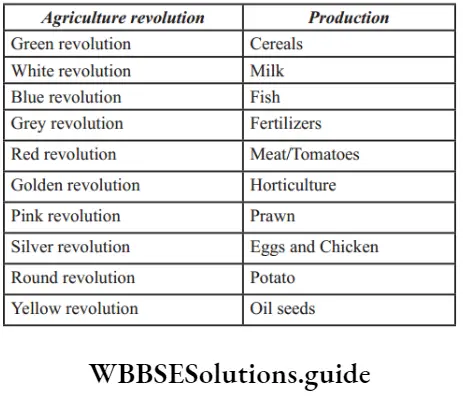
NEET Biology Class 9 Improvement in Food Resources Notes
Agriculture
The term “agriculture” is derived from two Latin words Agger-field and cultural-cultivation. Thus, agriculture is the branch of science that deals with the mass production of plants and animals useful to human beings.
It involves the study of:
- New methods of food production
- How new and better varieties of crops can be grown
- How animals like cows and hens can be reared well and made to give more milk or better quality eggs…etc.
All these new methods that scientists develop come under agricultural practices. We need vegetables, fruits, cereals, pulses, etc. as food. For our clothes, we need the fire of plants or animals. We get all these foods and fires by farming or agriculture.

Dependence Of Humans On Plants And Animals
- Humans are dependent on plants and animals for food. Most of our food items are either plant products such as grains, vegetables, and fruits or animal products like milk, egg, mutton, chicken, etc.
- We eat various parts of the plant as food. For example, grains of rice and wheat are seeds; radishes and carrots are roots; potatoes and ginger are stems. We also eat leaves and stems of spinach and plenty of fruits.
Crop:
- A Crop is a plant grown in the fields on a large scale to obtain food. For example, if all the plants of rice are grown in the field, then it is called a rice crop.
- Similarly, if all the plants of wheat are grown, then it is called a wheat crop. Crops are cultivated by humans for food, fodder, and other materials.
Let us discuss some important types of crops:
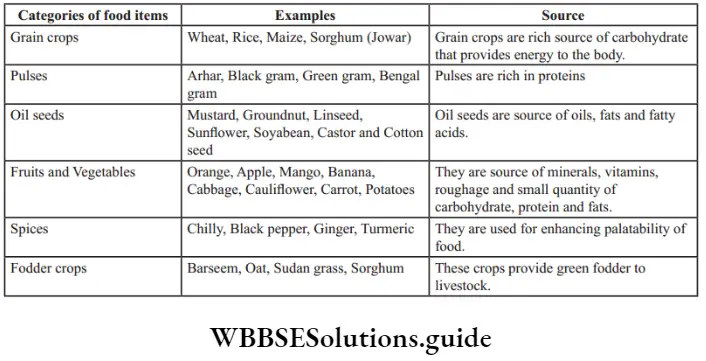
Improvement in Food Resources NEET Notes
Types of Crops
Different crops are grown in different seasons. Have you ever thought why? This is because each crop requires a different climatic condition, temperature range, and photoperiod for its growth and to carry out its life cycle. Therefore, some crops are grown in the rainy season while others are grown during winter.
Based on the seasons of cultivation, crops are classified into two categories:
- Kharif crops: The crops that are grown in the rainy season (or kharif season) are known as Kharif crops. These crops are cultivated between the months of June and October.
Examples of Kharif crops include paddy, maize, cotton, green gram, soybean, pigeon pea, and black gram. - Rabi crops: The crops that are grown in the winter season (or Rabi season) are known as Rabi crops. These crops are cultivated between the months of November and April.
Examples of Rabi crops include wheat, barley, gram, peas, mustard, and linseed. Such seasonal cultivation of crops assures maximum productivity of crops.
Question 1. Kharif crops are more susceptible to infestation by pests than the Rabi crops. Why?
Answer: Kharif crops are grown in the rainy season. Hence, these crops are more susceptible to infestation by pests as humid and warm conditions at that time are favorable for infestation.
Also, the yield of a crop can be increased by adopting a number of improved agricultural activities, which include three scientific approaches.
- Crop variety improvement
- Crop production improvement
- Crop protection management
These activities can be understood by following practices involved in farming.
The practices involved in farming can be divided into the following three stages:
- Choosing appropriate seeds for planting
- Nurturing the crop plant
- Protecting the growing crops and minimizing the loss of harvested plants Firstly, let us discuss the Crop variety improvement methods
1. Crop Variety Improvement Methods
- The high yield from the crops is directly related to the inputs and the agricultural practices that the farmers adopt. The higher the inputs, more is the yield.
- But before, going into the details of various methods of crop variety improvement, let us understand the need for crop variety improvement.
The various aspects for which crop variety improvement is carried out are as follows:
- To obtain a higher yield of crop
- To enhance the desirable quality of food items: Improvements are aimed at maintaining the quality of crop plants (nutritional factors). Improving crop quality is done in the following parts of plants:
- Protein quality in pulses
- Oil quality in seeds
- Preserving quality in fruits to reduce loss by spoilage
- To produce crop variety that is resistant to biotic and abiotic factors :
- Abiotic Stress: The problems caused by non-living factors are termed abiotic stress. The produced plants, which can resist them, are called abiotic stress-resistant plants
Some abiotic stress-resistant plants produced are- Drought resistant
- Salinity resistant
- Flood (water-logging) resistant
- Heat/cold/frost resistant
Therefore, producing plants, that can resist the attack by pathogens, is beneficial.
- Biotic Stress: Plants are attacked by insects, nematodes, and other disease-causing microbes, which can decrease the yield.
- The problems caused by living factors are termed biotic stress. The plants, that can resist them, are called biotic stress-resistant plants. Biotic stress-resistant plants are also called disease-resistant plants.
- Abiotic Stress: The problems caused by non-living factors are termed abiotic stress. The produced plants, which can resist them, are called abiotic stress-resistant plants
- To change the maturity duration of crops: By growing a plant that grows and yields faster, the crop cycle is reduced to increase profits. This reduces the cost that a farmer incurs during crop production. Thus, the shorter the duration of crops, the more economical the variety.
- ActivityUniform maturity allows the farmer to harvest crops together. Let us discuss, how? Take a handful of beans and sow them in the soil. Water the soil regularly and allow the beans to grow. You will observe that all plants do not grow together. Some grow faster while others grow much later.
- Imagine this problem in a vast farmland. If a farmer sows seeds and they do not grow uniformly, then they would not mature uniformly and thus he would not be able to harvest the yield at the same time. Therefore, it is necessary to germinate seeds that require similar conditions for sowing and maturity at the same time.
- To induce desirable agronomic traits: Tall branching plants are beneficial for plants whose leaves are to be utilized. For example, fodder crops that are grown to feed farm animals. Short plants are beneficial in cereals so that nutrients are not consumed by plants to grow taller.
- To develop plant varieties with wider adaptability: India is a country with varied regions. Certain regions are very fertile while others are dry with very low rainfall.
- Hence, all crop plants cannot grow in all regions. Therefore, crop plants that produce high yields in all regions with different conditions need to be produced.
Methods of Crop Variety Improvement
1. A farmer grows two varieties of rice, one which produces nutritionally rich grains during the monsoon season and the other which produces nutritionally poor grains in all seasons. He wonders if he could grow nutritionally rich grains in all seasons. Is it possible for him to do so?
- Hybridization is the method by which two characteristics present in different organisms can be brought together into one organism.
- A hybrid plant produced from two varieties will have characteristics from both the parent plants. Therefore, the farmer will be able to produce nutritionally rich grains, which can be cultivated throughout the year.
Steps to be followed to obtain an improved variety of crops are:
- Choice of parental plants: Select two existing varieties of plants having different desirable characteristics; say for example, one having higher yield and the other having more resistance to diseases.
- Cross-breeding of selected parental plants: This produces a new variety, which has characteristics of both parents. The process of crossing plants of two varieties having different traits to produce a hybrid having good traits of both is called hybridization.
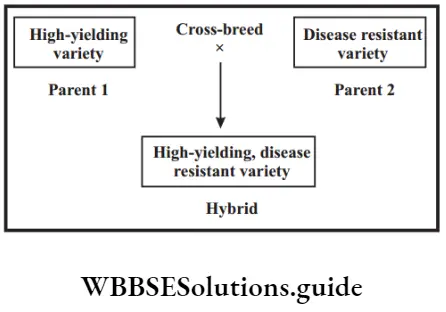
2. Introduction: It is the oldest method of crop improvement. It involves taking a new variety of a plant from an area where it grows naturally to a region where it does not occur before. The initial introduction of new varieties is carried out in those areas which have similar climatic and soil conditions. Slowly, the area is allowed to spread as the variety gets acclimatized to other conditions.
3. Artificial Selection: It involves picking up of plants with better traits for further multiplication. The selection operating for long time spans can give rise to varieties different from the starting generation. For example, cabbage, cauliflower, and broccoli have been obtained through artificial selection from wild cabbage.
4. Recombinant DNA technology: Genes are responsible for the features present in an organism. Therefore, another method to grow plants with the desired characteristics is to incorporate genes responsible for that character into plants. This method will result in the production of genetically modified plants. Thus, recombinant DNA technology transfers genes from one organism to another so as to modify the latter.
For example: Bt cotton is a genetically modified crop, which carries bacterial genes that protect the crop from insects.
By now, about 200 genetically modified crop varieties have been produced.
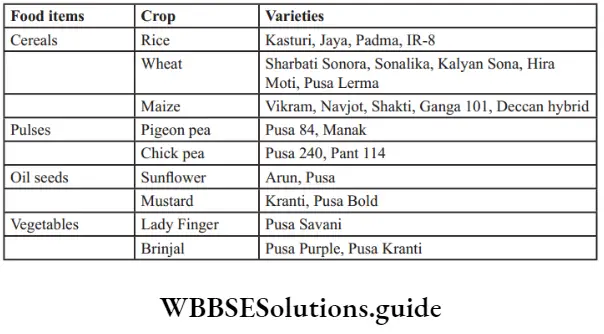
NEET Biology Improvement in Food Resources Important Notes
Crop Production Improvement
It involves controlling the various aspects of crop production so as to obtain the maximum quality yield. It has three components:
- Nutrient management
- Irrigation
- Cropping patterns
Let us discuss each of these components in detail.
1. Nutrient Management
Have you ever observed a plant growing in your garden? Have you ever thought about the sources from which a plant obtains nutrition? The plants absorb the nutrients and inorganic raw materials from their surroundings and utilize the same building up their organic matter. The main sources of nutrients for plants are air, soil, and water. In total, there are sixteen nutrients required by plants.
- Out of these, two nutrients (Carbon and Oxygen) are obtained from air.
- Hydrogen is obtained from water.
These three elements – Carbon, Oxygen, and Hydrogen are called non-essential elements as they are not obtained from the soil. - The remaining thirteen nutrients are obtained from soil with the help of roots. They are called mineral nutrients or essential nutrients.
Maze in 1915 divided essential plant nutrients into two categories-
- Micronutrients: Nutrients required in small quantities are called micronutrients.
- Macronutrients: Nutrients required in larger quantities are called macronutrients. Nutrients are essential elements, which are used by plants in large quantities.
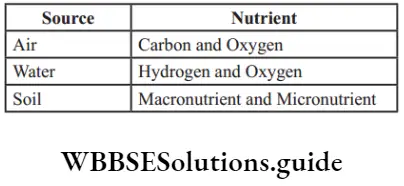
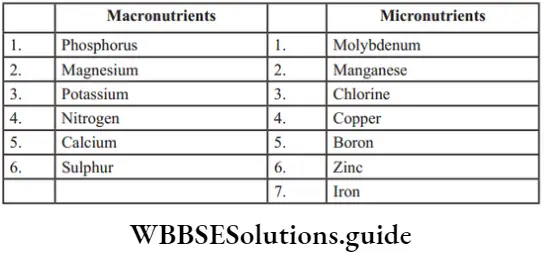
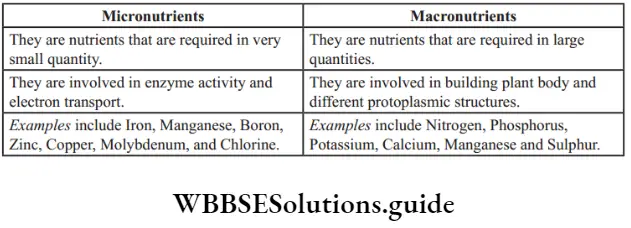
Mineral Replenishment
- Plants require essential elements for the growth and development of the body. When nutrients are not available to plants, physiological activity, such as growth, reproduction, and vulnerability to diseases, increases. Providing the proper quantity of nutrients to plants ensures proper growth.
- Sanjana germinated a few gram seeds in two different pots. She observed that some of the plants in pot A showed weak growth while the plants in pot B grew vigorously.
- Can you guess, why such variation is seen? One of the reasons for such variations could be a lack of certain nutrients. Lack of nutrients makes the soil infertile. So, unless the depleted plant nutrients are put back into the soil from time to time the growth of crops would be poor.
- But what are the ways by which nutrients can be added to soil? Soil can be replenished and the lost nutrients can be retrieved by adding manures and fertilizers. Let us learn about them.
Manures and Fertilizers
1. Manure: Manure is a natural fertilizer. It is prepared by the decomposition of plant and animal waste.
Composition of Manure
Manure is a source of many plant nutrients. It is composed of organic matter and minerals. Ammonia, nitrate, organic substances, etc. are predominant organic matters found in manures. Manures are mostly composed of micronutrients such as zinc, manganese, copper, magnesium, sodium, etc.
Best Short Notes for Class 9 Biology Improvement in Food Resources
Types of manures
Based on the kind of biological material used, manures can be classified as:
- Farmyard manure: Farmyard manure is formed from decomposed cattle dung (excreta) and urine, leftover fodder (cattle feed), and litter (bedding provided to cattle on the farm). These waste materials are collected daily from cattle sheds and stored in a pit for decomposition by micro-organisms (bacteria and fungi).
- Compost: Compost is manure made from vegetable and animal refuse collected from domestic waste, straw, and weeds, etc., dumped in a deep pit to decompose. During the process, microbes decompose the animal and plant waste and convert it into inorganic materials. These inorganic materials are excellent nutrients for plants.
Composting: is a biological process of converting dead organic matter into rich humus. It takes about 3 to 6 months for decomposition of organic refuse.
Vermicompost: is compost broken down by earthworms. Earthworms can consume practically all kinds of organic matter. This organic matter undergoes biochemical changes in the intestines of earthworms. Hence, earthworm converts matter into rich humus, thereby enriching the soil with nutrients.
- Earthworm used in vermicomposting is Dichogaster bolani and Drawida Willis.
- The process of composting ensures the continuance of the fertility cycle.
3. Green Manure: Green manure is formed inside soil from young green crop plants plowed back into soil. The crops plowed are generally quick-growing legume crops that are mulched by plowing them back into the field in the tender stage only. Examples of green manure are Sunn hemp, Cluster bean, Cowpea, Lentil, etc.
Advantages of manure
- It enriches the soil with organic material called humus to the soil.
- It increases the water-holding capacity of soil.
- It aerates the soil by making it porous.
- It helps in the growth of microorganisms. The organic matter of manures provides food for the soil organisms which helps in making nutrients available to plants.
- It improves the soil texture.
- It increases the crop production.
Disadvantages of manure
- Manures are bulky with low nutrient content.
- They are inconvenient to handle, store, and transport.
- Manures are not nutrient-specific. Hence, it is not very useful when a particular nutrient is required in the soil for a particular crop.
- The nutrients of manures are released slowly, not keeping pace with the high and rapid demand for nutrients by crops. So far, we have seen how natural materials are used as sources of nutrition for plants. Let us now discuss synthetic nutrients that are available to plants.
2. Fertilizers: What if plant nutrients are required in large quantities? Are there any synthetic nutrients available? Fertilizers are plant nutrients, which are commercially available.
- They can be organic or inorganic in nature. They ensure healthy growth and development in plants by providing them with nitrogen, phosphorus, potassium, etc.
- However, the addition of fertilizers to soil requires special guidelines to be followed such as dosage, time, post-addition precautions, etc. Fertilizers should not be applied directly to soil if the crop is standing. This is because, then it would bring about withering of crops due to the development of high osmotic concentrations around plants.
- Let us now discuss how composting is better than manufacturing fertilizers. Are there any advantages (or disadvantages) associated with the use of fertilizers in comparison to manures? Yes, there are.
Advantages of fertilizers
- They are mostly inorganic compounds, which can readily dissolve in water. They are easily available for plants.
- They are a good source of nitrogen, phosphorus, and potassium. However, they are good only for short-term use.
- They are nutrient-specific.
- They are compact and easy to store and transport.
- They are required in very small amounts.
Disadvantages of fertilizers
- They get washed away because of irrigation. Hence, they are a cause of water pollution.
- Continuous use of fertilizers causes harm to useful or symbiotic microorganisms living in soil.
- They can also result in the reduction of soil fertility.
- They cannot replenish the organic matter of the soil.
- They are quite expensive.
- They have only short-term benefit
Therefore, to get an optimum yield, it is necessary to use a balanced combination of manures and fertilizers.
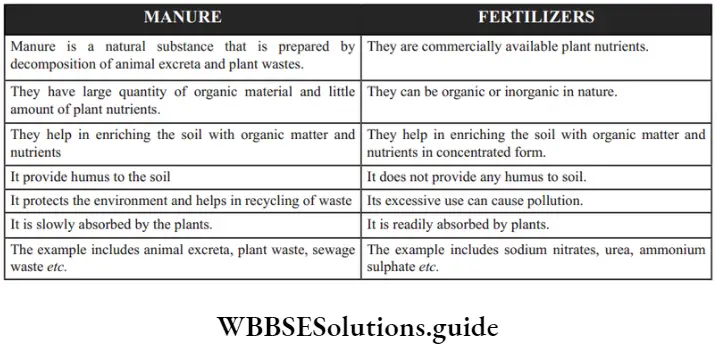
In the Lab
Let us perform an activity to find out how fertilizers and manures affect the growth of plants. Take some healthy gram seeds and allow them to germinate in a pot

Then take three empty jars and label them as A, B, and C. In jar A, add a small amount of soil mixed with green manure.
In jar B, add a similar amount of soil but mixed with urea, a fertilizer.
In jar C, add a similar amount of soil without any manure or fertilizer.
Now water all these vessels bearing soil.
Now from the pot, select three equal-sized seedlings and plant them in jars A, B, and C. Keep the vessel in a safe and lighted place.
Water them regularly and observe their growth.
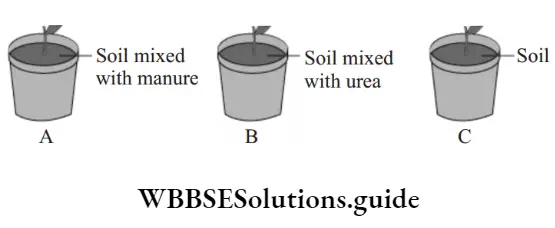
What did you observe after a few weeks?
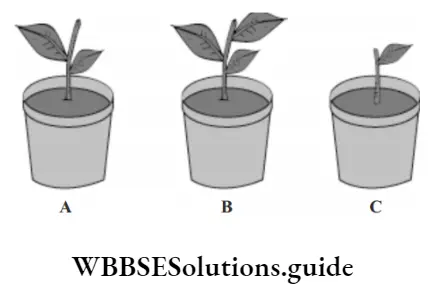
Improvement in Food Resources Class 9 NEET Key Concepts and Summary
You can observe that seedlings develop into small plantlets in all three jars after a few days. However, their growth varies in all the three. Jar B showed maximum growth while jar C showed the least growth.
Plantlets in jar B showed the maximum growth because urea is readily soluble in water and is quick-acting. When it is supplied to the soil, nitrogen is rapidly changed into ammonia. Later seeds use this ammonia for their growth and development. The plantlets in jar A also show growth but less as compared to jar B.
The growth of plantlets in jar C is the least because the soil is infertile as it lacks certain essential soil nutrients.
Question 1. Which one of the following crops would require a minimum quantity of NPK or urea for its proper growth and development?
Answer: The pea plant would require a minimum quantity of NPK or urea as they are leguminous plants and have the ability to fix atmospheric nitrogen themselves.
Question 2. Why is organic matter important for crop production?
Answer: Organic matter forms humus. Humus makes the soil fertile.
Importance of organic matter
- It improves soil structure by forming soil crumbs
- It increases the water-holding capacity of the soil.
- It improves the aeration of the soil.
- Decaying organic matter improves the growth of crop plants.
Is there any other method of providing nutrients to plants? Yes, Organic Farming.
Organic Farming: Organic farming is the practice of raising crops through the limited use of chemicals such as fertilizers, pesticides, herbicides, genetically modified organisms, etc. Sometimes they are not used at all. This method utilizes farm wastes such as excreta, a healthy cropping system (mixed cropping, intercropping, and crop rotation), the use of bio-pesticides such as neem and turmeric leaves mixed with stored gains, etc.
Advantages of Organic Farming
- It does not cause pollution of crop plants, soil, air, and water.
- It helps in recycling of waste materials.
- The food obtained from organic farming is free from pesticides and chemicals.
- It maintains the health of the soil.
- It keeps insects, pests, and weeds under check.
2. Irrigation
Water is essential for the growth of plants. Plants obtain water from soil and soil obtains water from rain. However, sufficient rain is not always there. It is, therefore, necessary to supply water to crop plants in the fields, periodically. The process of supplying water to crops in the fields is called irrigation. The various sources of irrigation are wells, canals, rivers, dams, ponds, and lakes.
Importance of irrigation
- It makes the soil soft which plowing easier.
- It provides moisture for the germination of seeds as seeds do not germinate in dry soils.
- Irrigation water helps in the absorption of nutrient elements by plants from the soil. The water dissolves the nutrients present in the soil to form a solution, which is then absorbed by the roots for the development of plants.
- Irrigation is essential for the growth and elongation of the roots of crop plants as the roots of crop plants fail to develop and elongate in dry soil.
The crop is irrigated according to its requirements and soil characteristics. Irrigation is essential during the seedling, flowering, and grain-filling stages of the crop. Rice crop needs standing water.
The irrigation of crop plants depends on the following two factors:
Nature of crop plants: Water requirements of different crops are different during various stages of growth. Some plants require more water, while others require less. For example, paddy crop is transplanted in standing water and requires continuous water supply while crops like wheat and maize require less water.
Nature of soil: The crops grown in sandy soil need irrigation more frequently than crops grown in clayey soil. This is because; clayey soil has good water-retaining capacity and thus needs irrigation less frequently. Sandy soil, on the other hand, is highly porous with poor water retaining capacity. Thus, crops grown in sandy soil need more frequent irrigation.
Irrigation Systems
There are a number of irrigation systems in India depending on the availability of water resources and the requirement of water by crops. The various sources of irrigation are wells, canals, rivers, dams, ponds, and lakes.
Based on water resources, the various irrigation systems are as follows:
- Tanks: Tanks are small storage reservoirs, which catch and store the runoff of smaller catchment areas. Small dams are built below the higher elevation of catchment areas. The outflows are regulated according to the water availability.
- Canal system: In this system, human-made canals receive water from rivers, storage lakes, dams, etc. The main canal passes into a branch canal, which in turn divides into distributaries. The distributaries ultimately supply water to the individual fields or groups of fields. Each field or group of files is given water by rotation.
- Wells: Wells are shafts sunk into the ground that reach the water table and are used to draw water. They are of two types:
- Dug wells: They are deep pits with the bottom reaching below the groundwater table. The water from the shallow strata slowly accumulates in the pits. The water is lifted by bullock-operated devices as well as pumps.
- Tube wells: They are deep bores used for pumping out water. The water is lifted by diesel or electricity or steam-operated pumps.
- River lift system: In this system, water is directly drawn from the rivers for supplementing irrigation in the areas near to rivers. This type of system is more useful in areas where canal flow is insufficient or irregular due to inadequate water release.
- River valley system: In riverine valleys with heavy rains, the slopes and valleys remain wet for a long duration to grow perennial crops like coconut, rubber, and tapioca.
- Drip system: In this method, water is delivered at or near the roots of the plant drop by drop. Water is passed through plastic pipes that have holes in it. These plastic pipes are then laid along the rows of crops. It is the most efficient method of irrigation as there is no wastage of water at all.
- Sprinkler system: This system supplies water to plants in the form of rain. The water is supplied using pipes to one or more central locations within the file. When water is allowed to flow under high pressure with the help of a pump, it gets sprinkled on the crops
Question 1. In a village, there is low rainfall throughout the year. What measure will you suggest to the farmers for better cropping?
Answer: Farmers should enrich the soil with humus. Humus increases the water-holding capacity of soil.
Farmers should use drought-resistant and early-maturing varieties of crops.
3. Cropping Patterns
Cropping patterns are models of raising crops that help in obtaining maximum benefits from a single piece of land. These patterns reduce the risk of crop failure, disease, and infestation.
The common types of cropping patterns are:
1. Crop Rotation: Have you ever been to a village? Farmers plant wheat crops during the month of November and harvest them in March and April. Similarly, rice crop is planted in June-July and harvested in October and November. The land that lies fallow in between these two cereal crops is used by the farmers for sowing a leguminous crop at this time.
- A leguminous crop does not take as long as wheat or rice to grow. So, by the time the farmer has to plant the cereal crops (rice, wheat, etc.) the pulse is ready to be harvested. Have you ever thought about why it is done so? What this type of method is known as? The practice of growing two or more varieties of crops on the same field in a sequential season is known as crop rotation.
- Generally, a leguminous crop like pulses, beans, and peas, is rotated with a non-leguminous crop such as wheat, maize, etc. Leguminous crops harbor nitrogen-fixing bacteria in nodules of their roots. These bacteria convert free nitrogen from the atmosphere into usable form.
- Thus, after the leguminous crop is harvested, the soil is left fertile for other crops. In this way, rotating different crops (leguminous and non-leguminous crops) in the same field replenishes the soil with nitrogen naturally and thereby increases crop production.
Advantages of crop rotation:
- It improves the fertility of the soil and hence brings about an increase in food production.
- It helps in weed control.
- It protects crops from diseases.
- It reduces the dependence on fertilizers.
- It results in the optimum utilization of nutrients as different crops obtain nutrients from different layers of soil.
NEET Biology Class 9 Chapter 5 Detailed Notes with Explanation
Question 1. How do crop rotations save a lot of nitrogenous fertilizer?
Answer: Growing a leguminous crop, during the rotation fixes atmospheric nitrogen with the help of their nitrogen-fixing bacteria. This reduces the need to add fertilizer to the soil.
Question 2. How does crop rotation restore the fertility of the soil and give better yield?
Answer: The practice of growing two or more varieties of crops on the same field in a sequential season is known as crop rotation. Generally, a leguminous crop like pulses, beans, and peas, is rotated with a non-leguminous crop such as wheat, maize, etc. The pulse crop uses different nutrients from the soil.
- It fixes the nitrogen from the air and makes the soil richer in nitrogen and thereby more fertile. This way the next cereal crop gives a better yield.
- If we do not practice crop rotation by growing different crops on a piece of land, but continue to grow the same crop, year after year, they will keep on using the same nutrients from the soil till all the nutrients in the soil get used up.
- The newly grown plants get poor nourishment from the soil and grow up to be weak and of bad quality. When plants are weak the insects can easily attack them and destroy them. Thus, crop rotation restores the fertility of the soil and gives better yield.
2. Multiple cropping: Multiple cropping is the growing of two or more crops one after another in the same field. It is of two types:
- Mixed Cropping: It is the technique of growing two or more different crops simultaneously on the same field. The farmers mix the seeds of two crops and sow in the field. It is like insurance against crop failure due to abnormal weather conditions and attacks of pests and pathogens.
For example:
- Maize + Urad bean
- Soybean + Pigeon pea
- Wheat + Chickpea
- Wheat + Mustard
- Barley + Gram
There are certain criteria that farmers follow while selecting different crops for mixed cropping.
Some of these are discussed below:
- The crops should not have the same root pattern. If one crop is deep-rooted, the other should have shallow roots.
- Both crops should have different water and nutrient requirements. If one crop plant requires a higher amount of water and nutrients, the other should require a lesser amount.
- Both crops should have different maturity times. If one is a long long-duration crop, the other should be of short duration or early maturity.
- The crops should have different growth habits. They should have a different structure of leaves, stems, branching patterns of stem, and flowers. If one plant is tall, the other should be dwarf.
- Always select the crops such that the products and waste materials of one crop stimulate the growth of the other crop. For example, if a wheat crop is grown along with a leguminous crop, then the usage of nitrogen from the soil by a wheat plant is compensated by the addition of nitrogen in the soil by the nitrogen-fixing legume. This in turn increases the soil fertility and ultimately the yield of the crop.
Need of following above criteria:
- All these criteria ensure that the component crops do not compete with each other for any of their requirement.
- It ensures that in case one crop fails, the other crop continues to flourish and cover the risk of the complete failure of one crop.
Advantages of mixed cropping:
- It reduces the risk of total crop failure.
- It increases the yield of crops due to the complementary effect of component crops.
- It tends to harvest a variety of produce such as pulses, cereals, vegetables, etc.
- It improves the fertility of soil and reduces the requirement for fertilizers.
- It helps in the optimum utilization of the soil.
- It reduces the chances of pest infestation.
- It enhances the optimum utilization of nutrients as they are absorbed from different layers of the soil.
Disadvantages of mixed cropping:
- The seeds of two crops are mixed and there is no set pattern of rows of crops. As a result, harvesting and threshing of crops separately is not easy.
- Farmers face difficulty in spraying pesticides and applying fertilizers to individual crops.
2. Intercropping: It is the practice of growing two or more crops simultaneously in the same fild in a definite row pattern. This technique enhances the productivity per unit area. The crops selected have different nutrient requirements and different sowing and harvesting dates.
For example:
- Soybean + Maize
- Bajra + Lobia
Advantages of intercropping:
- It increases the productivity per unit area.
- It saves time and labor of the farmer.
- It makes better use of natural resources of sunlight, land, and water.
- Since the seeds of different crops can be sown separately, so specific fertilizers required for each crop can be added.
- The produce of each crop can be harvested, threshed, and marketed separately.
- This method keeps a check on soil erosion.
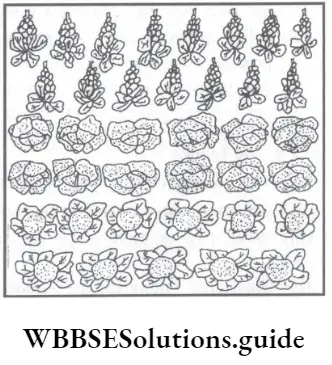
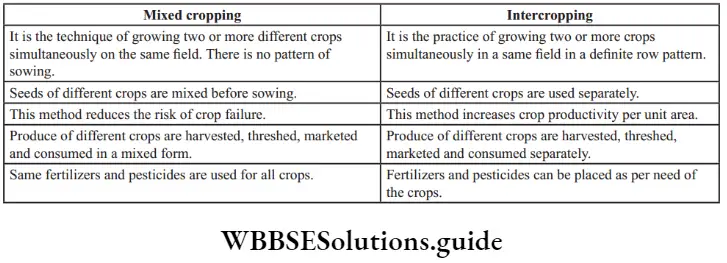
Question 1. A farmer cultivated soybeans in the field of Maize in well-planned rows. Explain the method of cultivation
Answer: Intercropping. Intercropping is the practice of growing two or more crops simultaneously in the same field in a definite row pattern. This technique enhances the productivity per unit area.
Crop Protection Management
Crops are affected by pests and a large number of weeds in fields. Uncontrolled growth of weeds and pests reduces productivity. Also, after harvesting, the produce is still in danger of getting spoilt by various biotic and abiotic factors. Therefore, these factors must be controlled to prevent loss. Crop protection management involves the protection of crops from their pests, pathogens, and weeds.
Let us first learn about the factors that affect crop plants and the measures used to control them.
- When you sow a food crop in the field, you must have noticed the growth of certain other plants along with major cultivated crops. What are these? These undesirable plants that grow in cultivated fields along with the crop plants are called weeds.
They compete with the crop plant for nutrients, light, and space. As a result, the crop plant gets lesser nutrients, light, and space. This also reduces the productivity of crop plants. Xanthium (gokhroo), Parthenium (gajar ghas), and Cyperus rotundus (motha) are some examples of weeds. - Pests are organisms like rats, insects, mites, fungi etc. that damage or destroy cultivated plants or plant products and make them unfit for human consumption. They destroy crops by the following methods:
- Sucking the cellular sap from various parts of the plant example. aphids, leaf hoppers, bugs.
- Cutting the roots, stem, and leaves of plants example. Locusts, hoppers, caterpillars, etc.
- Boring into stems, roots, fruits, and seeds example. shoot borer, cotton boll weevil, grain weevil, etc.
Examples of plant pests are the Gundhy bug that affects rice, shoot borer that affects sugar cane, aphid that affects mustard, etc.
- Microorganisms or pathogens cause diseases in crop plants. Pathogens can be bacteria, fungi, or viruses. These pathogens are generally transmitted through soil, water, and air.
Preventive measures of insect pests and weeds :
- Using pesticides is the most common method used to eradicate weeds, pests, and infectious diseases. These chemicals are generally sprayed on crops.
-
- Herbicides are used to eradicate weeds.
- Fungicides are used to destroy the fungus.
- Insecticides are used against insects.
Chemicals should be used in limited amounts. Excessive use of chemicals can lead to several environmental problems. Moreover, these chemicals are poisonous to plants and animals.
- The process of removing weeds from the cultivated field is called weeding. Weeds can be eradicated by the following methods:
- Mechanical removal: It involves pulling weeds with a hand. You must have seen farmers sitting in the field and uprooting certain plants with Khurpi. What are they doing? Farmers are actually uprooting the undesirable plants that are grown along with the main crop. Removal of weeds by using a trowel (Khurpi) and harrow is a manual method of removing weeds.
- Proper soil and seed preparation
- Timely sowing of crops, intercropping, and crop rotation. Weeds are very choosy about the crops with which they grow. Rotating the crop that has different nutrient requirements in the same field, disturbs the weed’s life cycle and reduces their growth in the same field.
- Use of a resistant variety of crops, which resist the attack of pathogens
- Proper plowing before sowing seeds helps in uprooting weeds.
- Spraying special chemicals called weedicides, like 2,4-D, Butachlor, Atrazine etc. on weeds.

Question 1. Why growth of weeds in the fields is harmful?
Answer: Weeds compete with the crops for nutrients, water, space, and light. They grow quickly, pick up more nutrients and water, and deprive the crop plants of essential inputs. As a result, the growth and yield of crop is reduced.
Question 2. A farmer was using excessive amounts of pesticides to safeguard the crop from blight. Will this have any ill effect on mankind? Justify.
Answer: Pesticides are toxic, poisonous, and often nonbiodegradable chemical compounds. They may have long-term damage to mankind. They cause irritation to the skin and the respiratory system.
Storage of Grains
After harvesting, the grains are stored in storehouses. There are certain factors (biotic and abiotic) that affect the produce after harvesting.
Different biotic and abiotic factors that affect the storage of grains are listed below in table
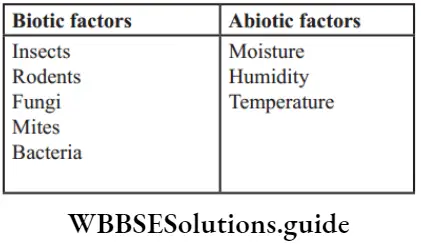
These Factors Result In:
- Weight loss
- Poor seed quality
- Poor germination capacity
- Discoloration of grains
- Poor marketability
- Infestation by insects, pests, etc
These factors bring down the cost and profits. Therefore, proper management of stored grains is important.
NEET Study Material for Improvement in Food Resources Chapter
Preventive Measures to be Taken Before Storing the Food Grains
- Maintenance of Hygiene: This includes:
- Cleaning of floors before storing the grains.
- The containers used for storing grains should be clean and dry with air-tight lids.
- Frequent chemical fumigation to kill pests, fungi, etc.
- Proper aeration and ventilation to control moisture and temperature levels.
- Drying: The grains can be dried in the sun or by blowing hot air on them. They are dried by spreading them over plastic sheets or on cemented floors. This is because, if the grains are spread directly on the ground, they will absorb more moisture from the ground.
- Maintaining storage containers: Godowns gunny bags or tanks or earthen pots used for storage should be free of cracks and holes and should be clean.
- Chemical treatment: Spraying or fumigation (insecticide solution converted into fumes) of godowns and containers with insecticides and fungicides should be done before storage. Care should be taken to ascertain that the grains for consumption by human beings are not treated with chemicals poisonous to human beings. Grains are often treated with neem kernel powder or pepper or mineral oil which prevents the laying of eggs by insect pests.
- Use of improved storage structures: Structures that are airtight, rat-proof, moisture-proof and can maintain a steady temperature are now used for storage. A few of them are named Pusa bin, Pusa cubicle, and Pusa other.
Animal Husbandry
- Ever since the beginning of civilization, humans have been trying to make use of animals around them for many requirements, such as food (milk, meat, and egg), clothing (wool), labor (carrying the load) security, etc. The development of desirable qualities in all such animal species, through creating better breeds, has been an important human achievement.
- For this, humans have consistently tried to improve the breeds of domesticated animals to make them more useful for them. The branch of science, that deals with the study of various breeds of domesticated animals and their management for obtaining better products and services, is known as animal husbandry.
- The term husbandry is derived from the word “husband”, which means “one who takes care”. Animal husbandry is the science of managing animal livestock. It involves feeding, breeding, and controlling diseases in farm animals. It involves the rearing of animals like cattle, poultry, and fish to obtain desired products from them.
- Milk-giving (milch) animals: Cows, buffaloes, and goats who give us milk.
- Meat and egg-giving animals: Pigs, cattle, goats, sheep, fowls, and ducks are the main sources of meat. From hens and ducks, we get eggs.
- Working (draught) animals: Bullocks, buffaloes, camels, and horses are draught animals used for doing work in the field and for the transportation of goods and human beings. Mules are also used especially by the army to take things from one place to another in the hilly areas.
Need for Animal Husbandry
- To increase milk production
- To increase egg production
- To increase meat production
- To increase fish production
- For proper utilization of cattle wastes like urine and feces. Cattle wastes are natural manure that enriches our soil and is used to generate biogas fuel.
Cattle Farming
- Have you ever visited a dairy farm? Many products like curd, cheese, butter, etc. are produced in a dairy. A dairy farm rears cows and buffaloes, which provide milk, the primary material for all these products.
- Milk as drawn from the cattle is known as full cream milk. When the cream is separated, the remaining milk is called toned milk.
This milk contains no fat and is known as skimmed milk.
The various milk products are:
- Cream: It is prepared by churning milk. The fat comes on the top which is separated by draining out the liquid. It is known as a cream with 10-70% fat content.
- Curd: Milk is converted to curd due to bacterial activities.
- Butter Milk: It is the leftover liquid after the removal of butter.
- Ghee: After heating butter, the water evaporates and the fat contents are almost 100%, forming ghee.
Cattle Breeds
In India, two different species of cattle are widely reared, Bos indicus (cow) and Bos bubalis (buffalo). The purpose of cattle farming is usually for the production of milk and labor in agricultural fields.
1. Milch animals (Milk-giving animals): Female dairy animals used to obtain milk are known as milch animals. The production of milk depends upon the lactation period.
Lactation Period is the period of milk production between the birth of a young one and the next pregnancy and it usually lasts about 300 days.
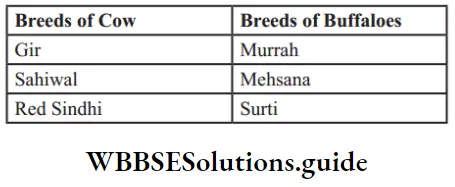
2. Draught animals (Working animals): Male animals engaged in agricultural fields for labor work like carting, irrigation, tilling, etc. are called draught animals.
Animal Breeding
- Animal breeding is the method of mating closely related individuals. In this process, two individuals of desirable characters are selected as parents. These are then crossed to obtain new breeds of animals. The new breed so obtained possesses the characteristics of both.
- For example, exotic or foreign breeds like Jersey, Brown Swiss, etc. are selected for increased milk production while local breeds like Red Sindhi, Sahiwal, etc. are selected for being highly resistant to diseases.
- These two breeds are crossed to produce a hybrid breed, in which both characteristics are available. Therefore, the offspring not only produces more milk but is also more resistant to diseases.
Objectives of Animal Breeding:
- To increase the yield of animals.
- To improve the desirable qualities of the animal produce.
- To produce disease-resistant varieties of animals.
A breed is a special variety of animals within a species. It is similar in most characteristics such as general appearance, size, configuration, and features to other members of the same species. Jersey and Brown Swiss are examples of foreign breeds of cattle. These two varieties of cattle have the ability to produce abundant quantities of milk. This milk is very nutritious with high protein content.
It is of three types:
1. Local or Desi or Indigenous breed: They are high-yielding varieties of indigenous (Indian) breed examples. Gir, Sahiwal, Thararkar, Kankrej etc.
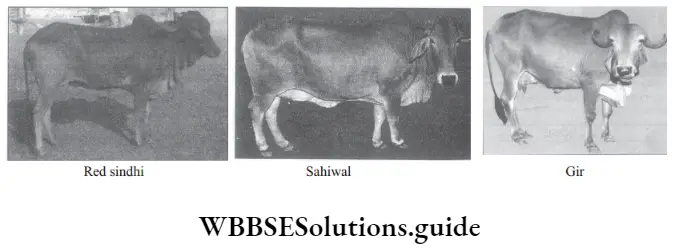
2. Foreign or exotic breed: They are high-yielding varieties that have been imported from foreign and reared widely in India example. Holstein, Friesian, Jersey, Swiss, etc
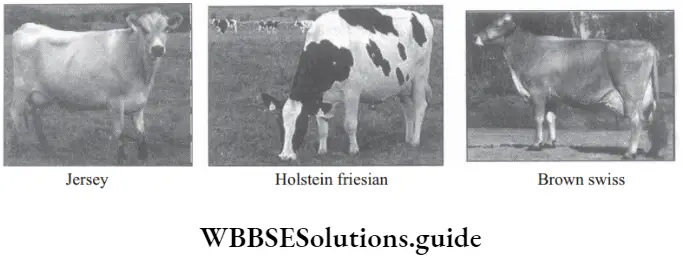
Improvement in Food Resources Class 9 NCERT Notes for NEET
3. Improved Breeds: They are hybrids that possess characteristics of both indigenous and exotic. example. Friewal, Karan Swiss.
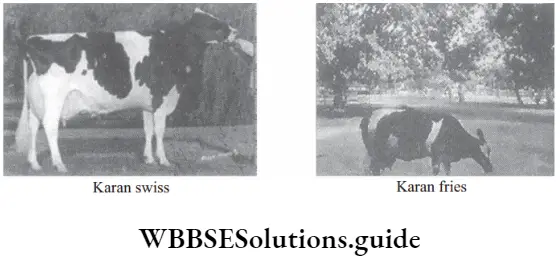
There are several methods employed in animal breeding, which can be classified into the following categories:
- Natural methods: of breeding include inbreeding and out-breeding. Breeding between animals of the same breed is known as inbreeding while breeding between animals of different breeds is known as outbreeding. Out-breeding of animals is of three types:
- Out-crossing: In this type of out-breeding, the mating of animals occurs within the same breed. Thus, they have no common ancestors up to the last 4-5 generations.
- Cross-breeding: In this type of out-breeding, mating occurs between different breeds of the same species, thereby producing a hybrid.
- Interspecific hybridization: In this type of out-breeding, mating occurs between different species.
- Artificial methods of breeding include modern techniques of breeding.
It involves controlled breeding experiments, which are of two types:-
- Artificial insemination: It is a process of introducing the semen (collected from the male) into the oviduct or the uterus of the female body by the breeder. This method of breeding helps the breeder overcome certain problems faced in abnormal mating.
- Multiple ovulation embryo technologies (MOET): It is a technique for cattle improvement in which super-ovulation is induced by a hormone injection.
- Then, fertilization is achieved by artificial insemination and early embryos are collected. Each of these embryos is then transplanted into the surrogate mother for further development of the embryo.
Advantages of artificial method of breeding:
The best method to carry out animal breeding is the artificial method of breeding, which includes artificial insemination and MOET technology.
- These technologies are scientific in nature. They help overcome problems of normal mating and have a high success rate of crossing between mature males and females.
- It ensures the production of hybrids with the desired qualities.
- This method is highly economical as a small amount of semen from the male can be used to inseminate several cattle.
- This method is more reliable and hygienic than the natural method of breeding animals by mating
Farm Management Practices :
Farm management practices play an important role in improving our livestock. It looks after the health of animals as well as the production of clean milk.
Farm management practices have four components:
- Feeding
- Housing
- Grooming
- Health care
Let us discuss each of these one by one.
1. Feeding of Cattle
- All animals must be fed properly. The food should contain essential nutrients required for the growth, development, and general maintenance of the body. The food that contains essential nutrients like carbohydrates, proteins, fats, minerals, vitamins, and water is known as feed.
- The main feed of cows and buffaloes is grass but this does not provide them all the nourishment. They require a balanced diet in the form of roughage which is firous food containing large amounts of fire such as hay fodder, leguminous plants-soybeans, peas, and cereals like maize, jowar, etc.
- The feed requirement of an animal depends upon age, growth, pregnancy, nature of work, and state of health.
For example, the food requirement of milch animals is of two types:
- The food helps in maintaining normal metabolic activities of the body.
- The food that is required during milk milk-producing period i.e. lactation period.
The cattle feed consists of two components:
- Concentrates: Concentrates are rich in nutrients, such as carbohydrates, proteins, fats, minerals, and vitamins, with very little fibrous matter. They are provided in the form of oil cakes, grains and seeds, rice bran, Grain chaff, etc.
- Roughage: Roughage is a coarse and fibrous substance that has a low nutrient content. It includes feed like straw and stems of cereal crops.
A poor quality of feed directly affects the yield of milk in cows and buffaloes.
2. Housing
Providing proper shelter to cattle is an important part of animal husbandry. It is necessary to protect animals from too much heat, rain, and cold. Cattle shelters have well-demarcated partially or completely covered areas where cattle can live comfortably and are protected from predators as well as natural factors like heat, cold, etc.
Characteristics of a good animal shelter:
- The shelter should be spacious. Each animal should get enough space to stay comfortably. It should not be overcrowded.
- The shelter should be clean, dry, airy and well-ventilated.
- It should have proper arrangements for hygienic disposal of animal wastes like urine and excreta.
- There should be proper arrangements for clean drinking water. Plenty of water should be available for cleaning the shelter and bathing animals.
- Prevention and cure of diseases at the right time should be ensured. Shelters should protect the animals from various diseases. The cattle shed to be properly covered with cemented floors having slopes for quick drainages.
3. Grooming
Cattle must be groomed regularly so as to remove dirt and loose hair from their body. Also, grooming removes parasites. Washing of animals should be done at regular times to further clean them so that they provide clean milk.
4. Health Care
Like human beings, castles are also prone to many infectious diseases. These diseases may affect milk production and may even cause death.
Some of the common diseases of cattle are:
- Viral diseases: These are caused by a virus and include foot and mouth disease, Rinderpest (cattle plague), Cowpox, etc.
- Bacterial diseases: These are caused by bacteria and example includes Anthrax, Salmonellosis, and Tuberculosis etc.
Prevention of cattle diseases:
- Cattle should be kept in a spacious, airy shelter with proper light and ventilation.
- They should be given regular baths and grooming to keep them protected from diseases.
- They should be given good, nutritive feed which will help them to resist infections.
- Each and every cattle should be vaccinated at regular intervals to immunize them against common infections and diseases.
- The shelter of animals should be cleaned properly and regularly.
Benefits of cattle farming:
- Good quality and quantity of milk can be produced.
- Draught labor animals can be produced for agricultural work.
- New varieties that are resistant to diseases can be produced by crossing two varieties with the desired traits.
2. Poultry Farming
Poultry is the rearing of domesticated birds –chicken, ducks, geese, and turkey, for eggs and meat. It is one of the fastest-growing segments of animal husbandry, as it is comparatively easy to start and maintain. It is the cheapest source of animal proteins for the non-vegetarian population.
There are two kinds of poultry:
- Broilers: The poultry reared for obtaining meat is called chicken or broiler.
- Layers: Poultry reared for obtaining eggs is called egger or layers.
How come you will know whether given eggs are of good quality or not? To understand this, let us perform a small activity.
Activity
- Take a few eggs and put them all in a container containing warm water. What did you observe? You will find that some of the eggs may be flat in water, while some of them will settle at the bottom of the containers.
- These settled eggs are of good quality while floating eggs are spoiled ones. This is because the shell is made up of calcium carbonate. Its deficiency results in a soft shell and makes it lighter in weight
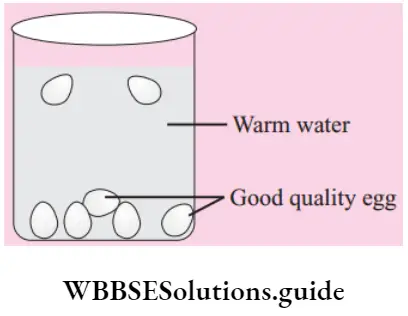
Poultry Breeds
Poultry breeds are divided into three categories:
1. Indigenous or desi breeds: These include Aseel, Kadaknath, Chattisgarh, and Bursa. These desi breeds are strong and possess natural immunity against common diseases. However, they have certain disadvantages:
- They are smaller in size.
- They are slow-growing.
- They lay small-sized eggs.
- They produce less number of eggs i.e. 60 eggs/year.
2. Exotic breeds: These are foreign breeds that have been successfully acclimatized in India. The example includes White Leghorn and Rhode Island Red. They have high egg-laying capacity but carry less flesh as compared to indigenous breeds.
3. Crossbreeds: These are improved breeds of poultry. The majority of present-day chickens are cross-bred blocks. For example, HH260, IBL-80, B-77 etc.
The crossbreeds of chicken have few advantages over the indigenous breed, such as,
- They lay more eggs i.e. 200 eggs/year.
- They yield more meat than desi varieties.
- The eggs produced are quite large as compared to indigenous breeds.
- Crossbreeds consume less feed as compared to indigenous breeds.
- They are best suited to the Indian climate.
Variety Improvement
It involves cross-breeding between Indigenous (Indian) and Exotic (foreign) breeds to develop improved varieties.
The improved varieties are developed for the following desirable traits:
- To produce improved quality and quantity of chicks.
- To develop dwarf broiler parent for commercial production for tolerance to high temperature.
- To develop a variety that has low maintenance requirements.
- To develop varieties, which utilize more cheap fibrous diet.
- To develop the reduced size of egg-laying birds, without reduction in the size of eggs.
Need for Poultry Farming
- Egg Production: Hens (Female fowls) raised for egg production are layers. For increasing egg production for the development of new improved variety with respect to quantity and quality of eggs, the following points are considered:
- Egg number/weight/size/shape
- Shell color/quality
- The internal quality of egg
- Body weight
- Feed efficiency
- Sexual maturity etc.
- Meat Production: Fowls raised to obtain meat are called broilers. They are generally males but can also be female. Broilers are fed with vitamin-rich supplementary feed for a good growth rate and better feed efficiency. Care is taken to maintain feathering and carcass quality.
Importance of Crop Production and Animal Husbandry NEET Notes
Management Practices
Good management practices are required to produce good quality birds. Nutritional, environmental, and housing conditions required by broilers are different from those required by egg layers.
The good management practices include
- Maintenance of temperature and hygienic conditions in housing
- Poultry feed
- Prevention and control of diseases and pests.
Housing and Feed: Layers are meant for egg production, whereas broilers are meant for poultry meat. They both require different types of care.
Depending upon the requirement of meat or egg production, poultry feed mainly consists of maize, rice, wheat bran, ground nut cake, fish meal, limestones, bone meal, common salt, vitamins, and minerals.
Care for the layers: Layers have two distinct phases in their life:
- Growing period, up to sexual maturity: The chickens at this stage are called growers. They require enough space. The feed is given in a restricted and calculated manner.
- Laying period: The period from sexual maturity till the end of egg laying is called the laying period. The chicks are known as eggers or layers. The layers, like growers, require enough space and adequate lighting. These factors have a favorable effect on the laying output of the hens.
The feed given to layers should be rich in vitamins, minerals, and micronutrients.
Care for broilers: A broiler chicken, for proper growth, requires vitamin-rich supplements, especially vitamins A and K. Also, their diet includes protein-rich food and enough fat. They also require extra care and maintenance to increase their survival rate in comparison to egg layers.
Shelter
Characteristics of a good poultry shelter:
- The shelter should be clean, dry, ventilated and well-illuminated
- It should be spacious and airy. Birds of different ages, like growing, egg-laying and brooding should be housed separately.
- The floor of the house should be covered with a litter of some dry absorptive material; which keeps the floor dry and warm.
- The poultry shed should be rat-proof and should be well protected from cat and dogs.
- It should have a proper temperature.
Diseases
Poultry birds are prone to many infectious diseases. These diseases may affect their growth and may even cause death.
Some common poultry diseases are:
- Bacterial diseases, like Cholera, Diarrhoea, Tuberculosis
- Viral diseases, like Ranikhet, Bird fl
- Fungal diseases like Aspergillosis
Prevention of diseases:
- Poultry farms should be spacious, airy, and well-ventilated.
- The shelter should be cleaned properly and regularly.
- Quick and hygienic disposal of excreta should be ensured.
- Birds should be vaccinated against common diseases and infections.
- Good nutritive, hygienic feed and clean water should be given to poultry birds.
- During winters, windows and walls of the shed of the poultry farm are covered to protect the birds from cold
Question 1. Write down three management practices that are common in dairy and poultry farming.
Answer:
- Spacious shelter: The shelter of both dairy and poultry farm animals should be clean, spacious, airy, well-ventilated, and safe.
- Proper feed: A regular, proper, and nourishing diet and fresh water should be provided to these animals.
- Timely vaccination: Animals should be properly vaccinated and checked for sickness.
3. Fish Production
Fish is an aquatic food that is a rich source of proteins. It is highly nutritious and easily digestible. A large section of the Indian population especially those living in the coastal areas uses fish as food.
Fisheries: It is the occupation of catching fish, prawns, lobsters, oysters, etc.
On the basis of the mode of obtaining fish, fisheries are of two types:
- Capture fishing: It is the process of obtaining fish from natural resources, both marine and inland.
- Culture fishery: It is the practice of farming fish. It is also known as fish farming or pisciculture.
Aquaculture: The growing of various types of aquatic animals that are of high economic value such as prawns, lobsters, fishes, crabs, etc. is called aquaculture.
Marine Fisheries: They are fish-catching areas found in the sea. It is of three types: coastal, offshore, and deep sea. The edible marine capture fish are tuna, sardines, Bombay duck, pamphlets, etc.
Mariculture: The culture of marine fish for commercial use is called Mariculture. For example, Mullets, Bhetki, Pearl spots, Eel, and Milkfish. Mariculture is growing rapidly as the demand for fish is decreasing while the stock is declining due to excessive exploitation from the sea.
Inland fisheries: The fisheries that deal with fresh and brackish water are known as inland fisheries. Fresh water occurs in rivers, reservoirs, lakes, and ponds while brackish water is found in estuaries and lagoons. Inland fisheries account for about 50% of total fish production in the country.
Inland fisheries are of two types: Culture fishery and Capture fishery.
Cultural fishery is a type of fishery practiced in small water bodies where fish is first reared and then harvested.
The fish culture is of different types:
- Monoculture, where a single species of fish is grown.
- Monosex culture, where fish of only one sex is grown.
- Poly-culture, where a combination of five to six species is grown.
Composite Fish Culture
- Due to over-exploitation and pollution, the availability of fish in natural water has declined considerably, which in turn has forced scientists to adopt various methods to increase its production.
- Farming fish under artificial conditions is the easiest way of increasing fish production and its availability for consumption. Farmers can take up fish culture in village ponds; tanks etc.
- And can improve their financial position, The technology developed for fish culture in which more than one type of fish is cultured simultaneously is known as composite fish culture. The technology enables to get maximum fish production from a pond or tank.
- Fishes with different food habitats are chosen so that they do not compete for food among themselves. For example, in an experiment, a combination of five to six species was used.
- Out of six species, three are of Indian origin (Catla, Rohu, and Mrigal) and three are exotic (Silver carp, Grass carp, and Common carp) from China.
- These six species have complementary feeding habits and do not harm each other. Basically, it constituted a good example of polyculture.
The food habits of six species are :
- Catla is a surface feeder that feeds on small animals.
- Silver carp is also a surface feeder but feeds on phytoplankton.
- Rohu feeds in the middle zone of the pond
- Grass carp feed on water weeds.
- Mrigal carp is a bottom feeder, which feeds on decaying plants and detritus.
- Common carp is an omnivorous bottom feeder. It feeds on all types of living organisms.
Advantages of Composite Fish Culture:
- Fishes do not compete among themselves for food as they all have different types of food habits.
- It ensures a complete utilization of food resources in the pond.
- It increases the yield of fish.
4. Bee Keeping
The practice of beekeeping is called apiculture (Latin. apis-bee, culture-cultivate). Apiculture is the rearing, care, and management of honey bees for obtaining products like honey, propolis, bee venom, etc.
Importance of Bee Keeping:
- It provides honey, a valuable nutritional food.
- It provides beeswax. Beeswax is secreted by the wax glands located on the underside of the last four abdominal segments (4th to 7th) of the worker bee. This wax is used in constructing bee combs in which the colony of the bees develops. Bee wax has many uses in the industry. It is used in cosmetics, creams, and ointments.
- It provides Propolis, which is antiseptic and antibiotic.
- Bee venom is used in the treatment of rheumatoid arthritis.
- Honey bees are excellent pollinating agents. Thus, it helps in increasing agricultural yield.
Purity Standards
- The term “adulterated honey” implies that the honey has been mixed with glucose, dextrose, molasses, corn syrup, sugar syrup, inverted sugar, flour, starch, or any other similar product, other than the floral nectar gathered, processed, and stored in the comb by honey bees.
- There is no ready method to test the purity of honey by the customers. Homogenous granulation is a probable sign of its purity.
However, let us perform a small activity to understand the purity of honey.
- Take a cotton wick and dip it in honey. Now burn the wick with a matchstick, if it burns, it is pure and if it is adulterated, the presence of water will not allow the honey to burn, and if still it burns, it produces a cracking sound.
- Generally, honey is adulterated by adding syrup of jaggery. Pure honey does not dissolve in water but impure honey dissolves. So, to test its purity, mix a spoon of honey in a cup of water and find out whether it dissolves or not.
Common Species of Honey bee:
There are two varieties of honey bees that are used for the commercial production of honey in India.
- Indigenous varieties, which include:
- Apis cerana indica (Indian bee)
- Apis dorsate (Rock bee)
- Apis flare (Little bee)
- Exotic varieties, which include:
- Apis mellifera (Italian or European bee)
- Apis Adamson (South African bee)
The Honey Bee Colony
Honey bees are social insects that live in colonies in nests or hives. There are different groups of bees in the same colony that perform different tasks.
A honey bee colony has three castes:
- Queen: The honey bee Queen is the supreme bee in a colony. All the activities in the hive revolve around her. Basically, she is the mother of the colony. She is responsible for laying eggs and lays about 2000 eggs in a day. She lays two types of eggs:
- Fertilized eggs that produce either sterile workers or fertile females, i.e., new queen.
- Unfertilized eggs that produce drones.
The queen lives for about 3 to 4 years.
- Workers: They are the most active members of the colony. They are actually imperfectly developed females, which cannot reproduce. Workers live for 3 to 12 months. The function of workers changes with age.
- During 1 first half of their life cycle, they do indoor duties. Each worker bee acts as a scavenger, cleaning the hive, like walls and floor of empty cells of the colony for reuse.
- They also start feeding the entire brood, with a mixture of honey and pollen. By the 7th day, it starts producing royal jelly. Royal jelly is fed to the queen and future queen bees. They also defend the colony from intruders by stinging.
- During the second half, they become field workers and perform duties outside the colony. They explore new sources of nectar. They collect nectar, pollen, and propolis. The nectar collected changes into honey in their crops.
- Drones: Drones are male bees produced by unfertilized eggs. They are males of the colony and depend for food on worker bees. rones are stingless and their main role is to mate with the queen.
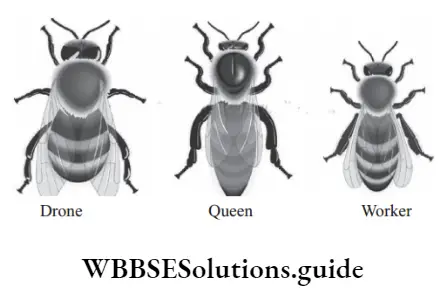
Formation of different castes in honey bee
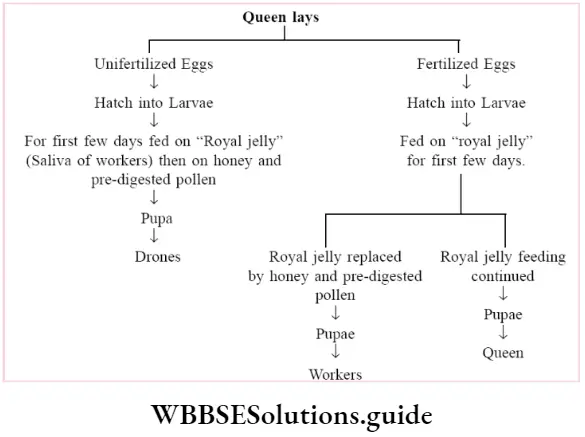
Management of High Yield of Honey
Apis mellifera, an Italian variety of honey bee, is commonly used for producing honey at commercial purposes. This variety is preferred and domesticated in our country as:
- Apis mellifera is gentle in nature.
- It has a good honey collection capacity
- It has the ability to protect itself from enemies.
- It has a prolific queen with less swarming
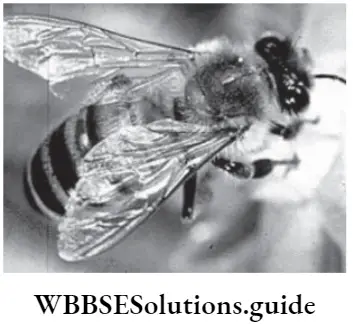
Let us now discuss the points that need to be considered in order to obtain good quality and high yield of honey.
1. Beehive: It is made of a series of square boxes without tops or bottoms, set one above the other. This hive has a floor at the bottom a crown board at the top, and a roof all over. Inside these boxes, wooden frames are vertically hung parallel to each other. The wooden frames are filled with sheets of wax foundation on which the combs are built by the bees.
The only entrance to the hive is below the large bottom box (brood chamber). The queen is usually confined to the brood chamber. The boxes termed “supers” are used for the storage of honey. The queen is prevented from going to the “supers” by the “queen excluder” who allows only the workers to move.

2. Apiary location: Apiary is a place where bees are raised and bred to get honey. It has a number of bee hives. It is set in a locality rich in vegetation, especially flowering plants. The hive should face the east side as it should receive sunlight during the morning and evening and some shade during mid-day.
3. Honey flow and season: To increase the yield of honey, apiaries should be established, at a location where there is an abundance of flora. The total time period during which honey bees collect nectar and pollens is called the honey flow period. This helps the bees to collect nectar and pollens in larger amounts which is ultimately converted into honey.
4. Swarming: Swarming is a natural phenomenon whereby the mass movement of bees takes place from one place to another. It takes place in the spring season for the purpose of reproduction. It is an old queen accompanied by a huge population of workers flinging to start a new hive. Swarms are collected from where they are settled. Some kind of a container is needed to collect the bees. The container is usually a straw basket with a lid.
5. Selection of variety: For honey production, the bee varieties with the following desirable characteristics are considered.
- The variety yields a high quantity of honey.
- Variety that does not sting much.
- A variety that stays in the beehive for long durations.
- A variety that breeds very well.
6. Site for beekeeping: A suitable site for apiary should be selected. It should have good pasturage which has a longer honey flow time.
Pasturage:
Pasturage is the availability of flowers from which bees collect nectar and pollen. The fruit trees, ornamental plants, and forest trees comprise important bee pasturage. It is related to the production of honey as it determines the taste and quantity of honey
Diseases of Honey Bees:
Honey bees are prone to many infectious diseases. These diseases may affect their yield. They are commonly infected by viruses, bacteria, fungi, and protozoa.
- Bacterial diseases: Example. Septicemia is caused by the Bacteria Bacillus apisceptious.
- Protozoan diseases: Example. Nosema disease, caused by Nosema APIs, and Amoeba disease caused by Vahlkampfi mollified.
- Fungi: Example. Brood foul disease caused by Schizomycetes.
Enemies of Honey Bees:
Common pests of honey bees are wasps, wax moths, mites, and king crows.
- Wasps are controlled manually by destroying wasp nests from the locality of the apiary.
- The wax moth is controlled by exposing bees in the bee hive to the sun, i.e. by increasing temperature.
- Bees eater birds like crows, sparrows, etc. are scared away by some device.
